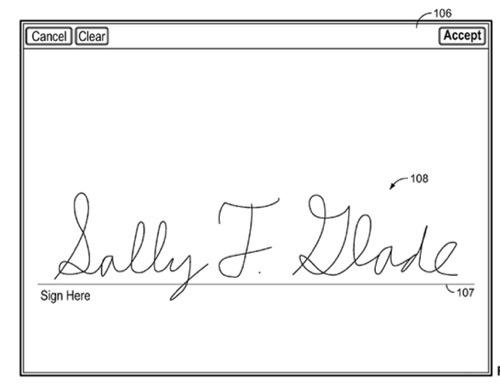An Apple patent (number 20120256944) has appeared at the U.S. Patent & Trademark Office showing that the company is working on handwriting recognition technologies.
The patent, for handwriting capture techniques, involves a set of rules used by a processor of a device to render a digital image of handwriting (e.g., handwritten signature) by connecting data points captured on a touch sensitive surface of the device with line segments or curves. A set of rules determines whether two given data points will be connected by a line segment or a curve. If a curve is used, the set of rules determine characteristics of the curve through the derivation of control points.
In some implementations, a smoothness adjustment factor can be applied to magnitudes of curve control points to reduce excessive smoothing for large distances between data points and maintain acceptable smoothing for short distances between data points. The magnitude can then be adjusted by multiplying by a constant factor which can be determined (e.g., heuristically) from the processing speed and resolution of the device upon which the curve is being rendered.
Here’s Apple’s background and summary of the invention: “Modern mobile devices (e.g., electronic tablets) can run applications that allow a user to capture their handwritten signature using a touch sensitive surface. For example, some delivery companies provide their delivery personnel with handheld devices that allow a customer to sign for a package by writing their signature on a touch sensitive display surface of the device using a finger or stylus. Unfortunately, if the device is capable of capturing only a few signature data points per second, and if the finger or stylus is moved quickly, there may be an insufficient number of signature data points to generate a smooth and continuous rendering of the signature.
“A set of rules is used by a processor of a device to render a digital image of handwriting (e.g., a handwritten signature) by connecting data points captured on a touch sensitive surface of the device with line segments or curves. A set of rules determines whether two given data points will be connected by a line segment or a curve. If a curve is used, the set of rules determine characteristics of the curve through the derivation of control points.
“In some implementations, a smoothness adjustment factor can be applied to magnitudes of curve control points to reduce excessive smoothing for large distances between data points and maintain acceptable smoothing for short distances between data points. The magnitude can then be adjusted by multiplying by a constant factor which can be determined (e.g., heuristically) from the processing speed and resolution of the device upon which the curve is being rendered.
“Particular implementations of handwriting capture techniques provide one or more of the following advantages. Smooth and continuous rendering of handwriting (e.g., electronic signatures) can be produced from a small set of data points captured by a touch sensitive surface.”
The inventors are Lyndley Crumly and David Clark.




